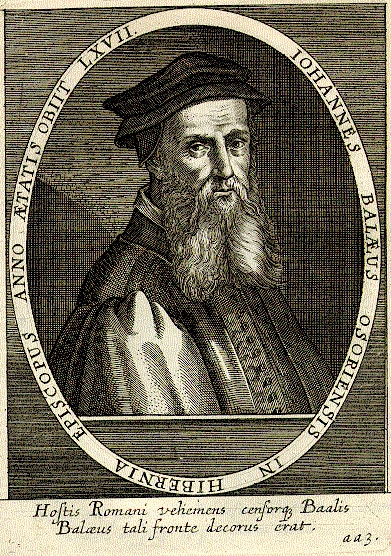The Library is currently undertaking a project to reorganise the rare-book collection, which can bring to light intriguing items. We recently rediscovered two editions we hold of the same text, printed in 1544 and 1729, both bearing a similar title page despite the different printing dates. One copy has had a mysterious hand-drawn title page inserted in place of the original. What had inspired a previous owner to do this, and where had the original page gone? This blog post explores what the similarities and differences between two copies of the same text printed almost two centuries apart can tell us.
Turbulent times
The text in question is A brefe chronycle concernynge the examinacyon and death of the blessed martyr of Christ Syr Iohan Oldecastell the Lorde Cobham, collected togyther by Iohan Bale, an anti-Roman Catholic martyrology. Written by John Bale, an evangelical protestant polemicist, it concerns the trial and execution of Sir John Oldcastle for the crime of heresy. It was first printed in 1544, making one St. Anne’s copy a first edition, during the English Reformation under Henry VIII. Bale was dismayed by the conservative nature of Henry VIII’s religious reforms, feeling they did not go far enough towards removing Catholic doctrine from the English church. He had been arrested in 1537 for preaching heresy in a sermon denouncing ‘papistry’ and by 1544 Bale had fled England for the continent, where he continued to produce outspoken religious works.
In this historical context the narrative of John Oldcastle, a Lollard knight and the first influential layman to be accused of heresy, would have been appealing to Bale who presents him as proto-martyr for the Protestant cause. The Lollards were a proto-Protestant movement, often derided or looked upon as heretics, who opposed many Catholic practices and were critical of the Roman Catholic Church. Oldcastle refused to accept multiple opportunities to renounce his faith or receive pardons from the King due to the strength of his religious convictions, and instead chose to remain an outlaw until his capture and execution for his faith. The text concludes by naming John Oldcastle a blessed martyr of Christ ‘not canonysed of the Pope, but in the precyouse Bloude of his Lorde Iesus Christ’, presenting him as a hero of Protestant ideals.
A risky business
Restrictions on publishing under Henry VIII meant that Bale had his works printed on the continent and smuggled to England, where they would sometimes appear under pseudonyms. Although Syr Iohan Oldcastell… bears Bale’s name and a printing year, there is no information on the printer or location.
The English Short Title Catalogue, a comprehensive union catalogue of early printed material, gives the printer as Hans Luft. Luft’s imprint information often gave his location as Marburg or Marlborow, but recent scholarship has suggested that the books were more likely to have been printed near Antwerp. Hans Luft has also been suggested to be a pseudonym, with Johannes Hoochstraten and Martinus De Keyser, both printers of Protestant works, suggested as candidates for Luft’s ‘true’ identity. Such secrecy was necessary for printers of religiously controversial works, as publishing them entailed significant personal risk.
By contrast, in 1729 Protestant King George II ruled England. Printing works with anti-Catholic sentiment was clearly no longer considered controversial, as the 1729 edition gives a printing location of ‘Pater-noster-row, London’, and names C. Davis as the printer. This edition also introduces several paratexts including a preface where the author corrects mistakes in the original text and addresses contested aspects of Oldcastle’s story, 44 pages of appendix material providing historical context, along with a dated summary of events with page references. The text had moved from something being printed cheaply and secretly to something that had intellectual work dedicated to it, resulting in a scholarly edition for an educated audience.
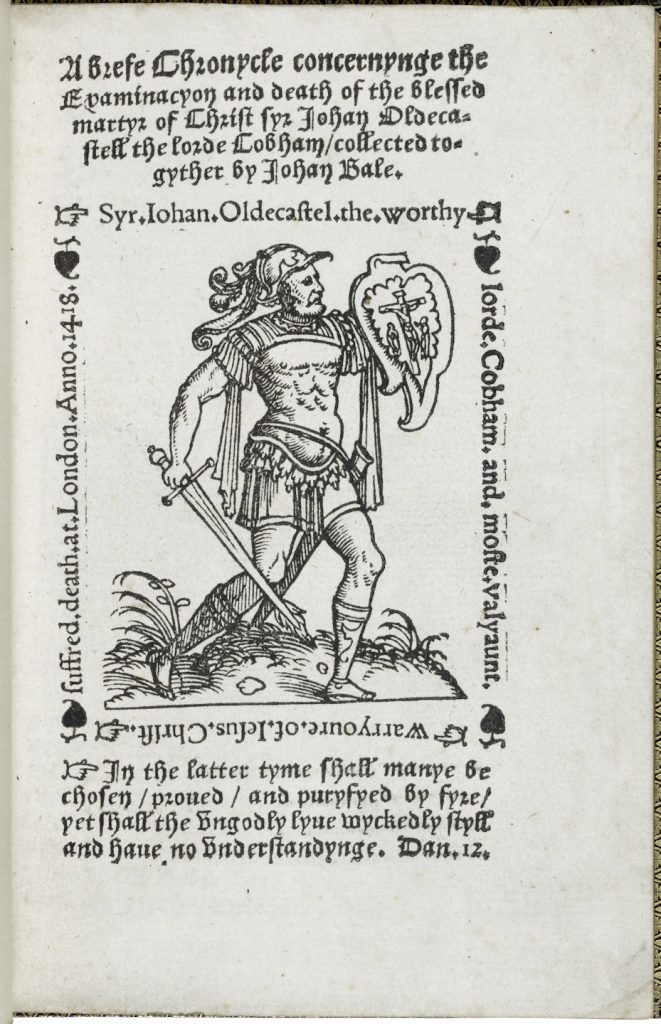
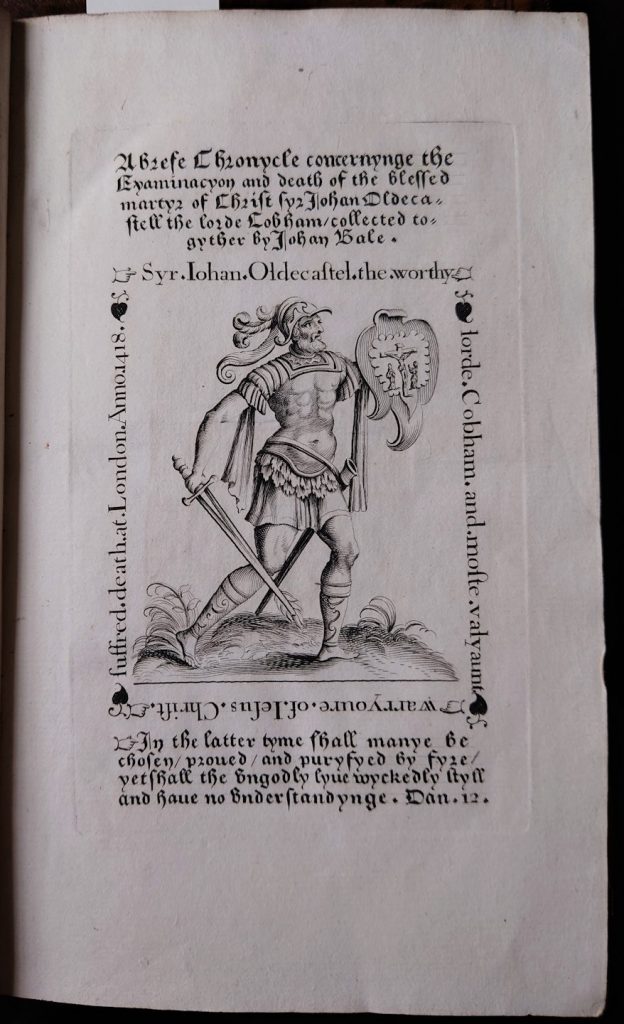
An enduring image
The first edition of the text was printed with full-length woodcut portrait of Sir John Oldcastle, depicted and literally identified by the text framing the image as a ‘Warryoure of Iesus Christ’. He wears the symbolic armour of Ephesians 6:13-17, carrying a shield bearing the crucifixion in his left hand and the flaming sword of the Word of God in his right. The 1729 edition goes to great lengths to retain the spirit of the original title page, replicating the page arrangement, typefaces, punctuation and typographical arrangement as a copper plate engraving. The portrait has been updated with the increased detail made possible by intaglio printing methods, though still remains true to the original. Therefore, this title page must have been important to the text as a whole when it was first published.
However, the St. Anne’s 1544 copy is missing its original title page and a manuscript (hand-drawn) page has been inserted in its place. The evenness of the paper the copy is drawn on compared to the lined surface the rest of the text is printed on shows this page was added during a much later rebinding of the book, around the 1750s or later. By this time, smoother ‘wove’ paper was being used in book making rather than lined ‘laid’ paper. What would force an owner to draw their own version of a title page into their book, centuries after its printing?
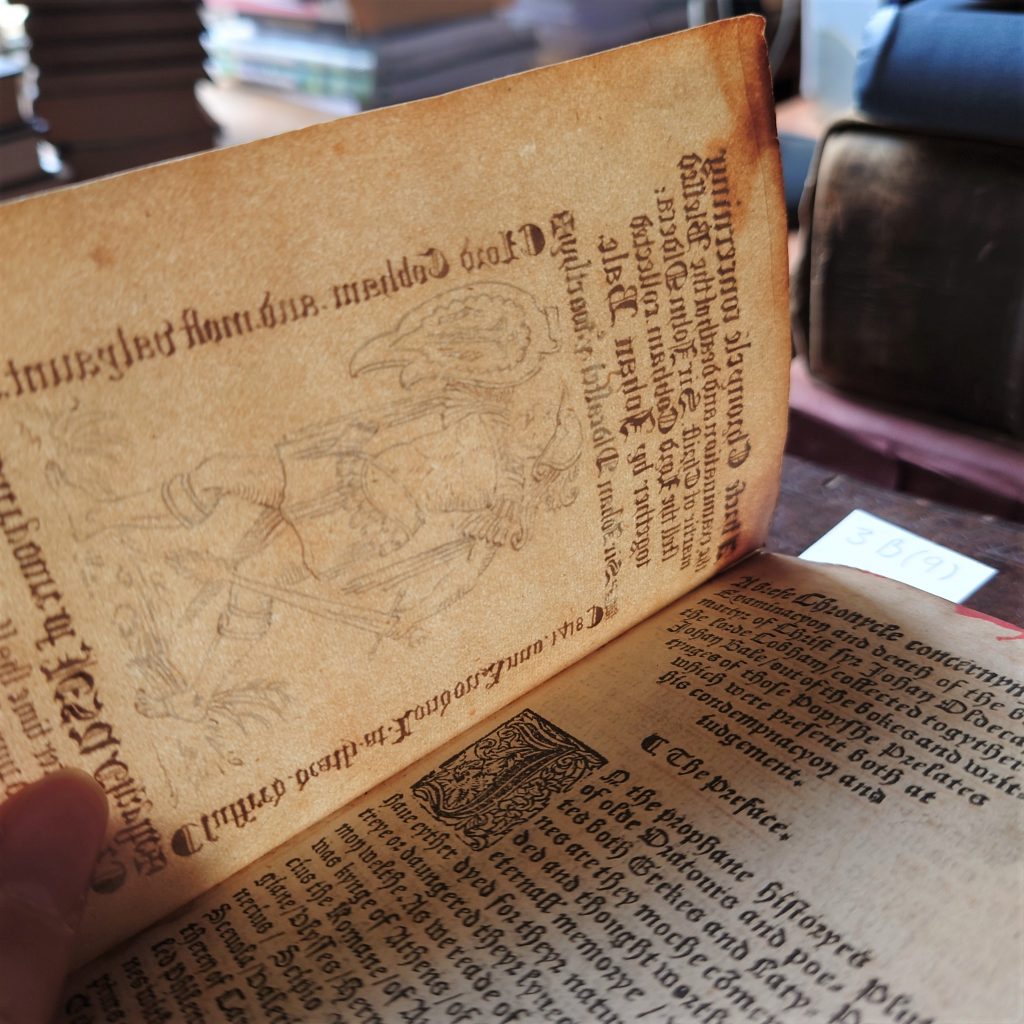
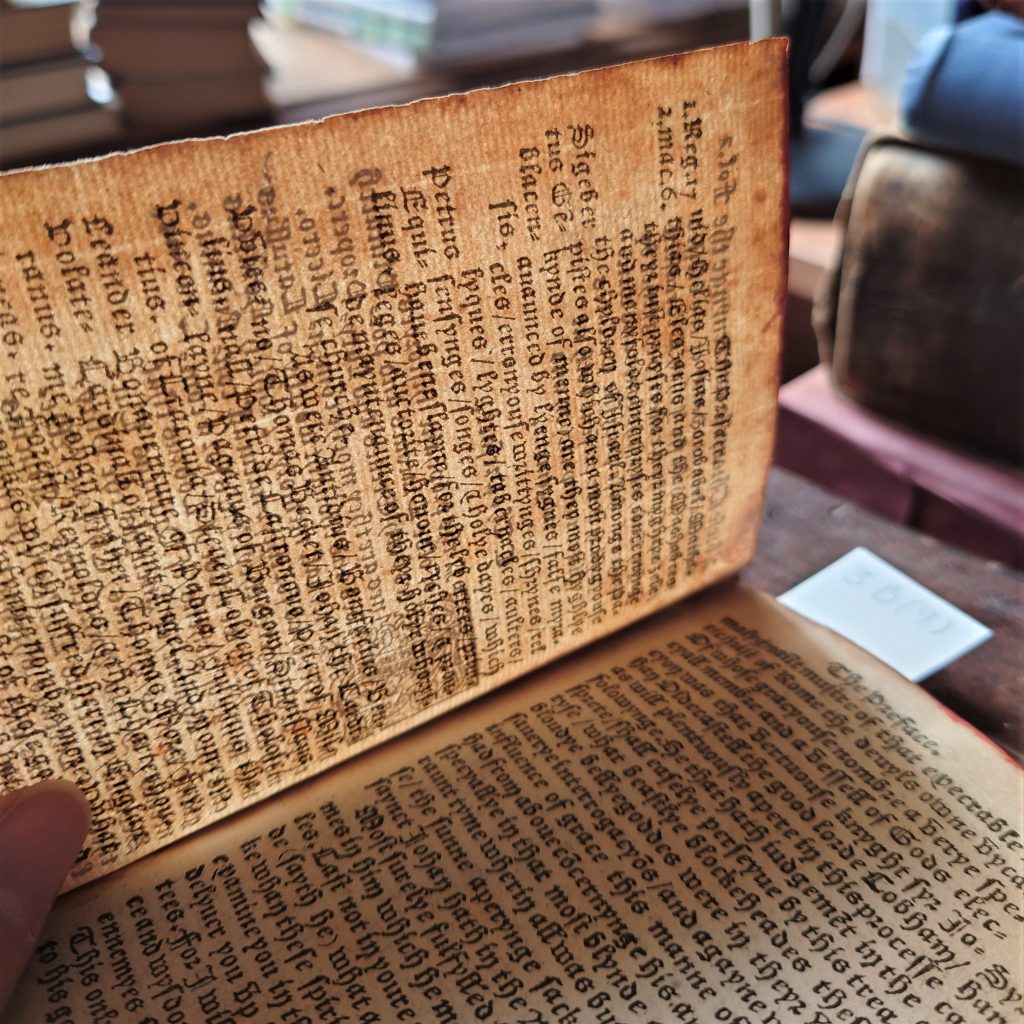
Bibliographer W. Herbert owned two copies of Syr John Oldcastle… and had seen another one, all lacking their title pages. He suggested this defacement was on account of the ‘imaginary portrait on the title page’ [emphasis Herbert’s]. S. R. Maitland also proposed that Oldcastle’s classicised portrait and religiously significant armour could have motivated damage to the copies. Perhaps those removing the title pages were appalled by the image of a Lollard hero and martyr, and the anti-Catholic sentiments he embodied.
The creator of the title page obviously felt restoring it was important, and it was not unusual for Early Modern book owners to make extensive manuscript additions to their printed books. However, either by accident or through a lack of available copies to study, the owner recreated the title page from the edition printed in 1548 rather than 1544.
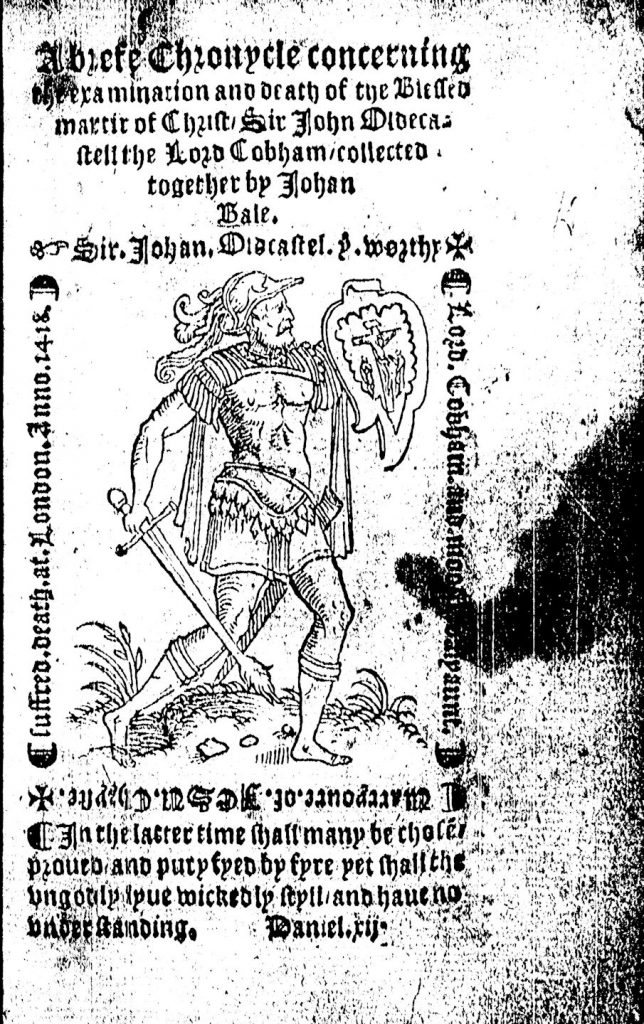
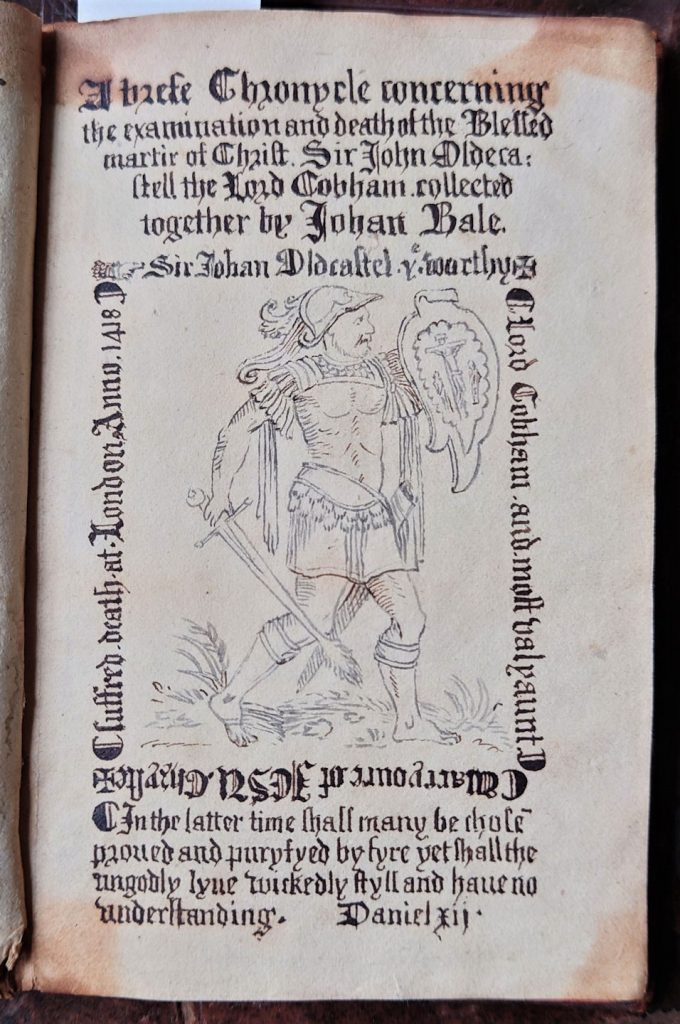
There are some significant differences between the original 1544 title page and that found in the St. Anne’s copy which make this clear. For example, the text around the portrait is in a Roman typeface in 1544, but in 1548 it is a blackletter or ‘gothic’ face. The spellings of several words from the title change between the editions, and the 1548 spellings have been faithfully recreated by the copyist. The 1548 woodcut portrait is also of inferior quality, missing the finer detail on Oldcastle’s leg armour and sword. Despite the incorrect title page, we know the St. Anne’s copy is the earlier edition because of the date given in the colophon.
Prestigious provenance history
By contrast our 1729 copy doesn’t have extensive manuscript additions from previous owners, but evidence of ownership does exist through bookplates. Two armorial bookplates belonging to John Boyle, 5th Earl of Orrery & Cork, have been pasted into the book. One takes after the bookplates of his father Charles Boyle, 4th Earl of Orrery, in style, featuring the family arms and motto alongside an unusual floriated border. The second, larger, bookplate dates from 1753 or later, when Boyle had succeeded his cousin Richard as Earl of Cork.
Due to a strained relationship with his son, Charles Boyle bequeathed the majority of his substantial library to Christ Church, the Oxford college they both attended. Though a few volumes on English history were given to John, a lack of Charles’s ownership marks makes it unlikely that this book was one of them.
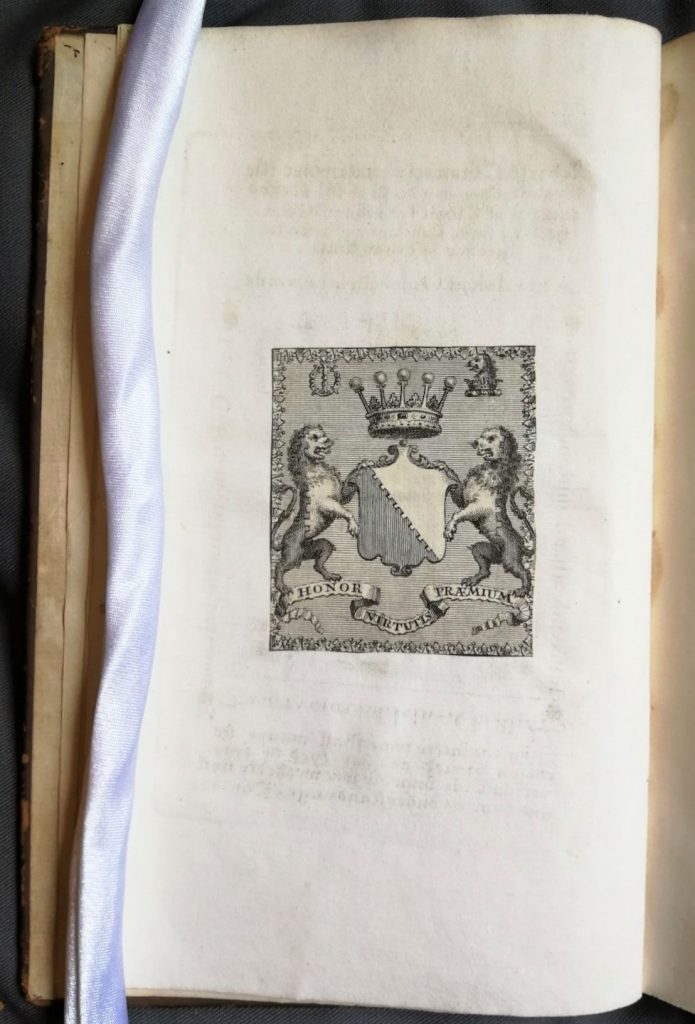
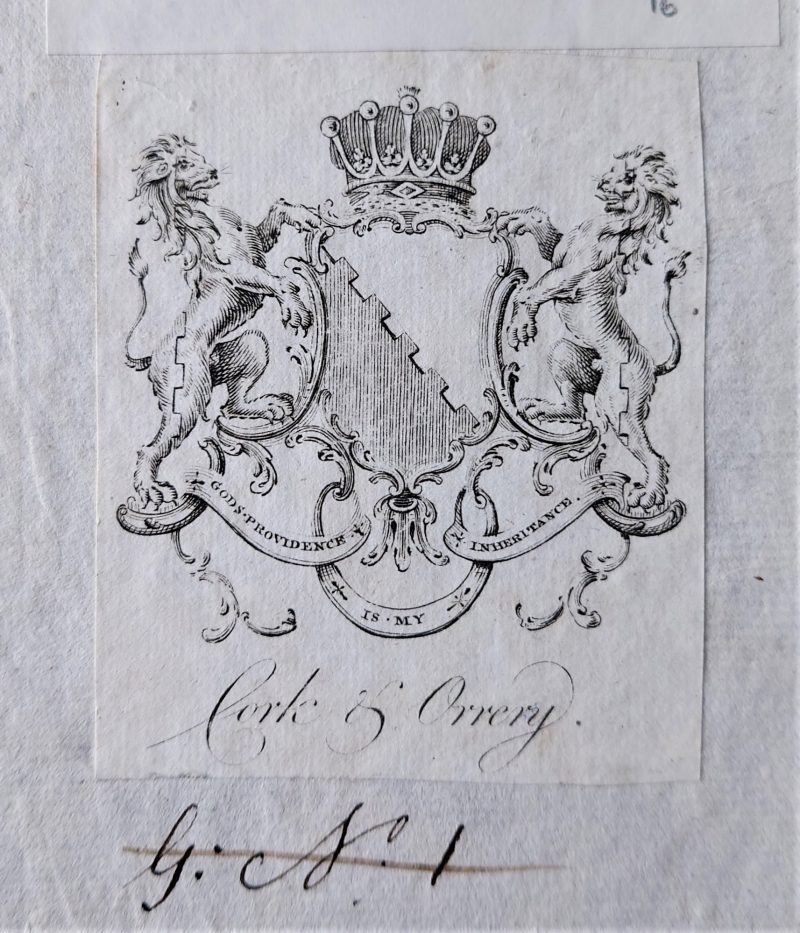
The book came to be part of the St. Anne’s rare-book collection through the bequest of Claude Jenkins, a Canon of Christ Church. John Boyle’s library and papers were removed from his home at Marston, Frome, in Somerset and sold in 1905. An catalogue of the auction held in the Bodleian Library is heavily annotated with the buyers of his letters, mostly antiquarian booksellers, and it is likely they also purchased most of his book collection. It is therefore likely that Jenkins purchased the book at a dealer’s, which he was known to frequent. It’s possible Jenkins was aware of the Orrery/Boyle association with Christ Church and that motivated his purchase, however he is known to have collected vociferously and his collection includes many bookplates from noble and non-noble owners, meaning it is impossible to determine if this attracted him to the book.
Taken together, these copies demonstrate the persistence of a text which was initially printed against all odds, preserved by those sympathetic to Reformation ideals, and endured turbulence to become an accepted narrative. The powerful image of a Protestant martyr remains central to the text throughout multiple iterations, creating a clear link back to the original even as modern adjustments were made.
This article was written by Lauren Ward, Senior Library Assistant.
